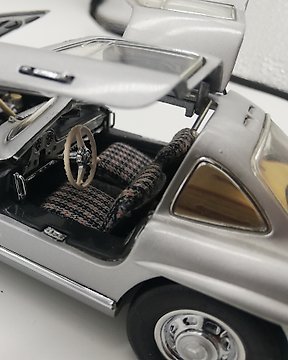
Franklin Mint 1:24 - Sedán a escala - 1954 Mercedes Benz 300 SL
N.º 82528277

N.º 82528277

1951 Citroen 2CV done by Franklin Mint, Precision Models, probably around 1987.
The Citroën 2CV (French: deux chevaux, pronounced [dø ʃ(ə)vo], lit. "two horses", meaning "two taxable horsepower") is an economy car produced by the French company Citroën from 1948 to 1990.
Introduced at the 1948 Paris Salon de l'Automobile, it has an air-cooled engine that is mounted in the front and drives the front wheels.
Conceived by Citroën Vice-President Pierre Boulanger to help motorise the large number of farmers still using horses and carts in 1930s France,[4] the 2CV has a combination of innovative engineering and straightforward, utilitarian bodywork.
The 2CV featured overall low cost of ownership, simplicity of maintenance, an easily serviced air-cooled engine (originally offering 6.7 kW (9 hp)), and minimal fuel consumption. In addition, it had been designed to cross a freshly ploughed field with a basket full of eggs on the passenger's seat without breaking them, because of the great lack of paved roads in France at the time; with a long-travel suspension system, that connects front and rear wheels, giving a very soft ride.
Often called "an umbrella on wheels",the fixed-profile convertible bodywork featured a full-width, canvas, roll-back sunroof, which accommodated oversized loads, and until 1955 even stretched to cover the car's trunk, reaching almost down to the car's rear bumper. Michelin introduced and first commercialised the revolutionary new radial tyre design with the introduction of the 2CV.
Between 1948 and 1990, more than 3.8 million 2CVs were produced, making it the world's first front-wheel drive car to become a million seller after Citroën's own earlier model, the more upscale Traction Avant, which had become the first front-wheel drive car to sell in similar six-figure numbers. The 2CV platform spawned many variants; the 2CV and its variants are collectively known as the A-Series.
Notably these include the 2CV-based delivery vans known as fourgonnettes, the Ami, the Dyane, the Acadiane, and the Mehari. In total, Citroën manufactured over 9 million of the 2CVs and its derivative models.
A 1953 technical review in Autocar described "the extraordinary ingenuity of this design, which is undoubtedly the most original since the Model T Ford".
In 2011, The Globe and Mail called it a "car like no other". The motoring writer L. J. K. Setright described the 2CV as "the most intelligent application of minimalism ever to succeed as a car",[18] and a car of "remorseless rationality".
Both the design and the history of the 2CV mirror the Volkswagen Beetle in significant ways.
Conceived in the 1930s, to make motorcars affordable to regular people for the first time in their countries, both went into large-scale production in the late 1940s, featuring air-cooled boxer engines at the same end as their driven axle, omitting a length-wise drive shaft, riding on exactly the same 2,400 mm (94.5 in) wheelbase, and using a platform chassis to facilitate the production of derivative models.
Just like the Beetle, the 2CV became not only a million seller but also one of the few cars in history to continue a single generation in production for over four decades.
Cómo comprar en Catawiki
1. Descubre algo especial
2. Haz la puja más alta
3. Paga de manera segura